Tiny homes are gaining popularity, but their unique design requires a specialized approach to inspections. At Outbuilders, we’ve seen firsthand how crucial a thorough tiny home inspection can be for potential buyers.
This guide will walk you through the key areas to focus on, common issues to watch out for, and how to choose the right inspector for your tiny home purchase.
What to Look for in a Tiny Home Inspection
A thorough tiny home inspection focuses on four critical areas: structure, electrical systems, plumbing, and climate control. These elements ensure the safety, functionality, and longevity of your tiny home.
Structural Integrity
The foundation is the starting point. For tiny homes on wheels, inspect the trailer for rust, damage, or weak spots. Permanent structures require a check of the foundation for cracks or settling issues. Examine the framing, with special attention to load-bearing walls and roof trusses. Tiny homes have at times encountered legal trouble and concerns have been raised about their habitability, however, they have found several niches.
Electrical Systems
Tiny homes often feature unique electrical setups. Confirm that all wiring meets code requirements and has proper insulation. Inspect the main electrical panel for appropriate amperage. The NEC has a minimum service disconnect rating for a single family residence of 100A, 3 wire (230.79(C)). Test all outlets, switches, and fixtures for proper function. The National Fire Protection Association identifies faulty wiring as a leading cause of residential fires, making this inspection vital.
Plumbing and Water Systems
Check all plumbing connections for leaks or signs of water damage. Test water pressure and drainage in sinks, showers, and toilets. For tiny homes with composting toilets or greywater systems, verify proper installation and venting. The Tiny House Design and Construction Guide recommends PEX piping for its flexibility and durability in small spaces.
Climate Control
Proper insulation and ventilation play a key role in tiny homes. Verify the R-value of insulation in walls, floors, and ceilings. Look for drafts around windows and doors. Evaluate the heating and cooling systems (many tiny homes use mini-split systems or radiant floor heating). Adequate ventilation prevents moisture buildup, which can lead to mold issues.
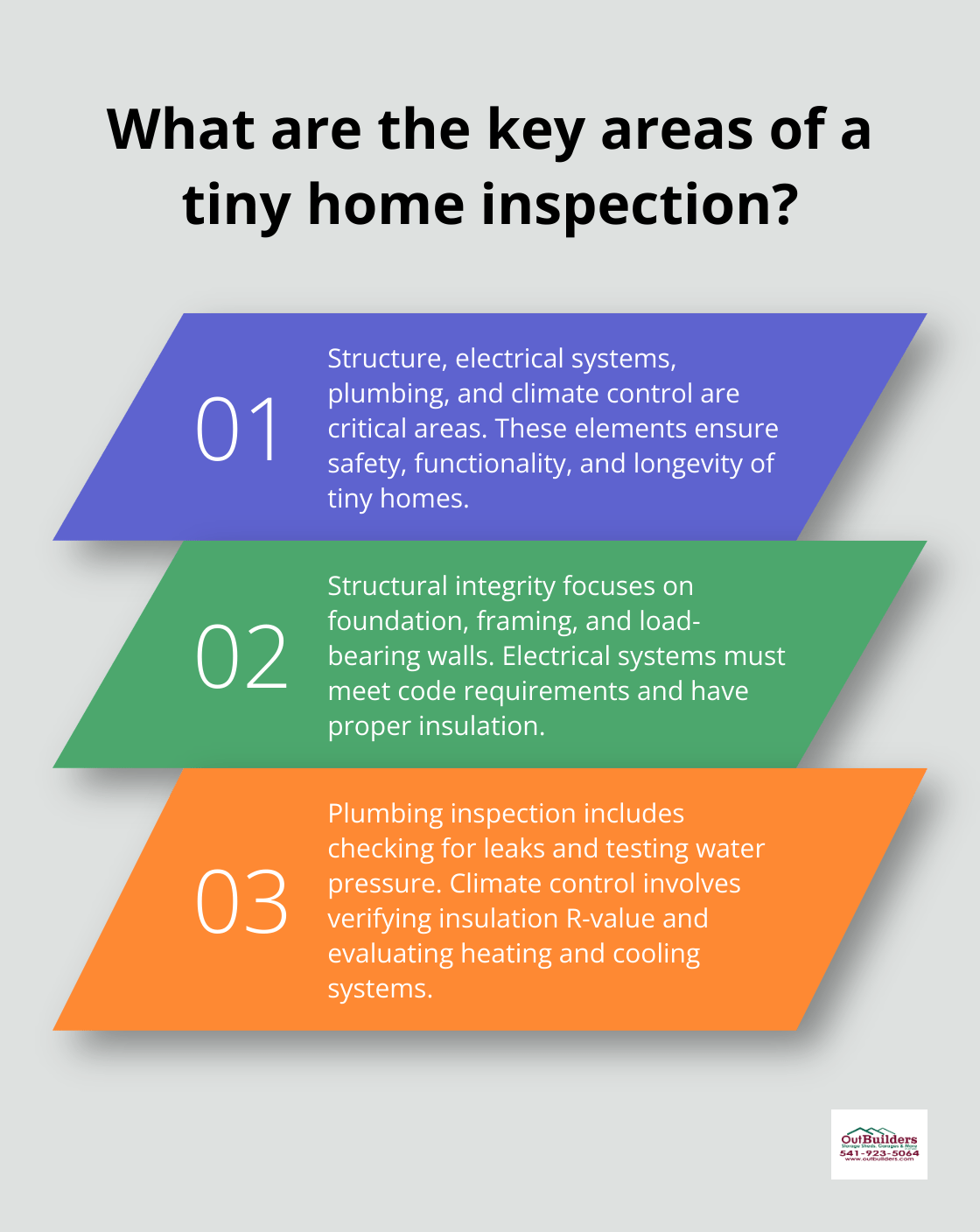
Tiny homes often have unique features that require specialized knowledge. Working with certified tiny home inspectors provides the most thorough evaluation. While companies like Outbuilders specialize in custom storage solutions, they recommend engaging experts familiar with tiny home construction for inspections.
The next section will explore common issues found during tiny home inspections, helping you identify potential problems before they become major concerns.
Hidden Dangers in Tiny Homes
Tiny homes often conceal issues that aren’t immediately apparent. These problems range from minor inconveniences to serious safety hazards. Let’s explore some of the most common hidden dangers in tiny homes.
The Silent Threat of Moisture
Moisture poses a significant threat in tiny homes. The limited space means water intrusion can quickly lead to mold growth. A well-ventilated space can help reduce moisture levels and prevent mold and mildew growth.
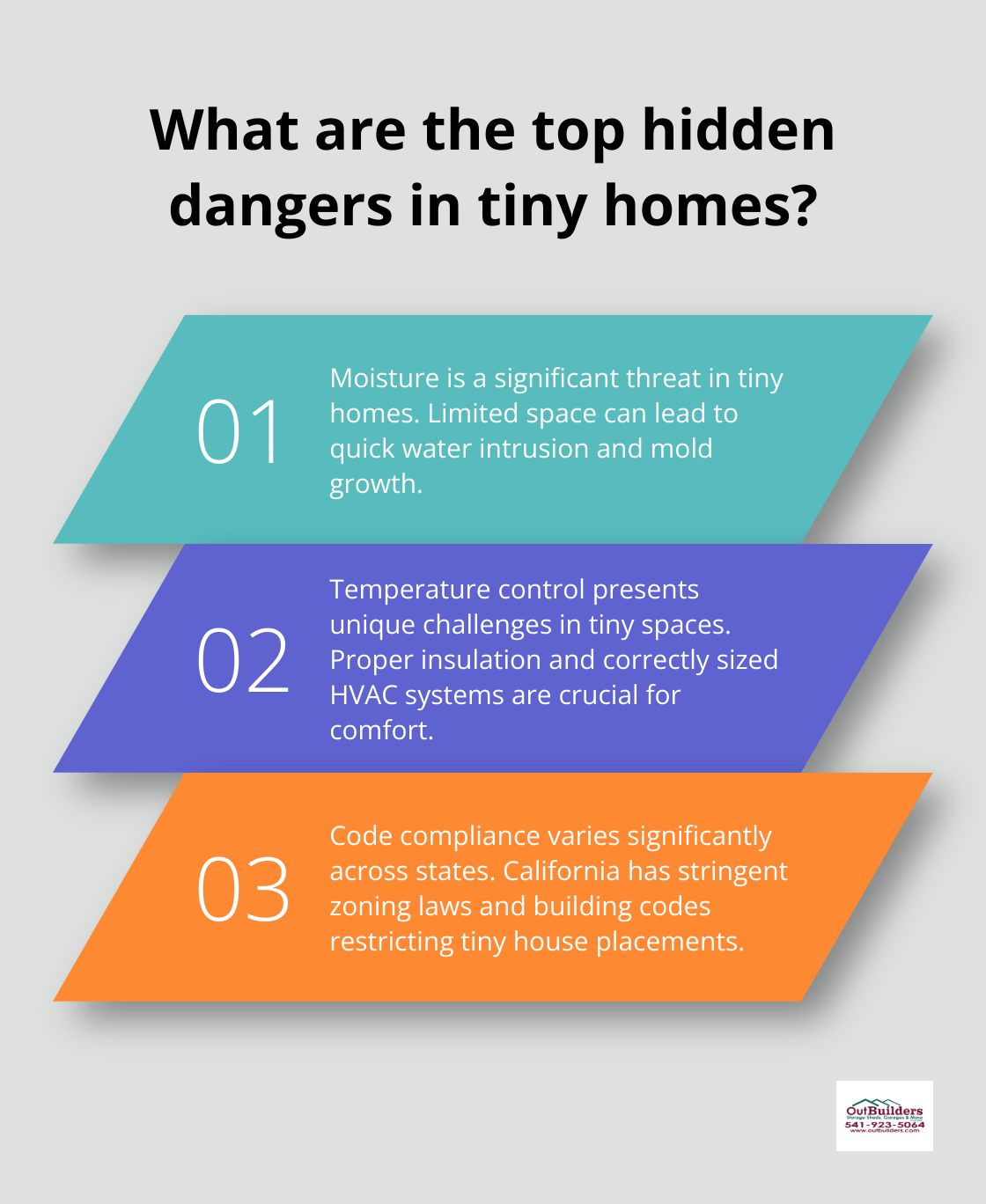
To combat this issue:
- Install a robust ventilation system
- Use exhaust fans in bathrooms and kitchens
- Consider installing vents or other forms of ventilation
- Perform regular checks for leaks around windows, doors, and plumbing fixtures
Temperature Control Challenges
Heating and cooling a tiny space presents unique challenges. Many tiny homeowners struggle with temperature extremes.
The solution often involves:
- Proper insulation
- Correctly sized HVAC system (Mini-split systems are popular, but must be sized appropriately)
Code Compliance Conundrums
Building codes for tiny homes can present significant obstacles. Many areas still lack specific regulations for these unique structures. Legal hurdles vary significantly from state to state. In California, stringent zoning laws and building codes restrict tiny house placements.
Before purchasing or building a tiny home:
- Research local zoning laws thoroughly
- Understand requirements for permanent foundations vs. wheels
- Check restrictions on parking duration
Loft Safety Concerns
Loft areas in tiny homes often lack proper safety features. Falls are a leading cause of home injuries, and lofts without adequate safety measures increase this risk.
When inspecting a tiny home’s loft:
- Check that ladders are sturdy and well-secured
- Ensure staircases meet local building codes for rise and run
- Verify the presence of railings (at least 36 inches high)
- Check headroom in the loft area (this is often inadequate)
While companies like Outbuilders focus on creating perfect storage solutions, it’s important to work with specialized tiny home inspectors who can spot these unique challenges. Their expertise can make the difference between a dream tiny home and a costly mistake. In the next section, we’ll discuss how to choose the right inspector for your tiny home, ensuring you catch these hidden dangers before they become major problems.
Finding the Right Tiny Home Inspector
Seek Specialized Experience
Not all home inspectors can evaluate tiny homes effectively. You should look for professionals with specific tiny home experience. These experts understand the unique challenges of compact living spaces, from efficient use of vertical space to specialized electrical and plumbing systems.
Certification and inspection of tiny houses are done by third party agencies such as Pacific West Associates, RADCO, PFS, and ICC NTA. This highlights the importance of finding a specialized inspector.
Verify Credentials and Training
Check for certifications from recognized organizations like the National Association of Certified Home Inspectors (NACHI) or the International Association of Certified Home Inspectors (InterNACHI). These bodies offer specialized training in tiny home inspections.
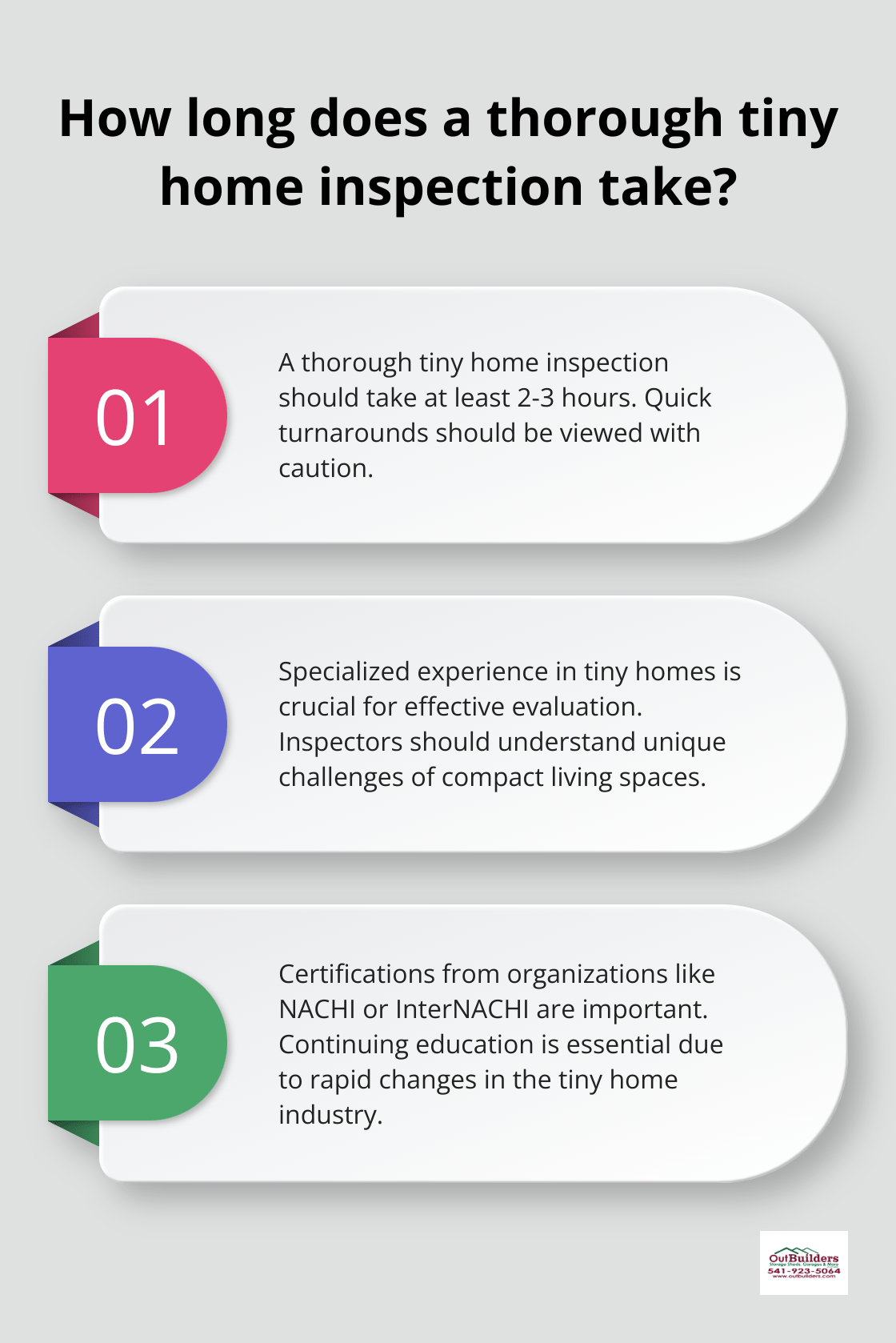
Ask potential inspectors about their continuing education. The tiny home industry changes rapidly, and staying current with new building techniques and regulations is essential.
Evaluate Inspection Methods
A thorough tiny home inspection should take at least 2-3 hours. Be cautious of inspectors who promise quick turnarounds. Ask about their process and what tools they use. Thermal imaging cameras, for instance, can detect hidden moisture issues (a common problem in tiny homes).
Request a sample report to assess the depth and clarity of their assessments. A good report should contain details, be easy to understand, and include photos documenting potential issues.
Consider Local Knowledge
Local inspectors often possess invaluable knowledge about area-specific challenges and regulations. For example, in Central Oregon (where Outbuilders operates), understanding local climate considerations and zoning laws is essential.
Regulations can vary dramatically even between neighboring counties, which underscores the value of local expertise in tiny home inspections.
Compare Multiple Options
Don’t settle for the first inspector you find. Try to get quotes and information from at least three different inspectors. This comparison will help you understand the range of services and prices available in your area.
Ask each inspector about their experience with tiny homes specifically. How many have they inspected? What unique challenges do they often encounter? Their answers will give you insight into their expertise and approach.
Final Thoughts
A thorough tiny home inspection protects your investment and ensures safety, functionality, and compliance with local regulations. Early detection of issues allows for easier and less expensive repairs, preventing small problems from escalating. Knowledge empowers you to ask the right questions during the inspection process and make informed decisions about your purchase.
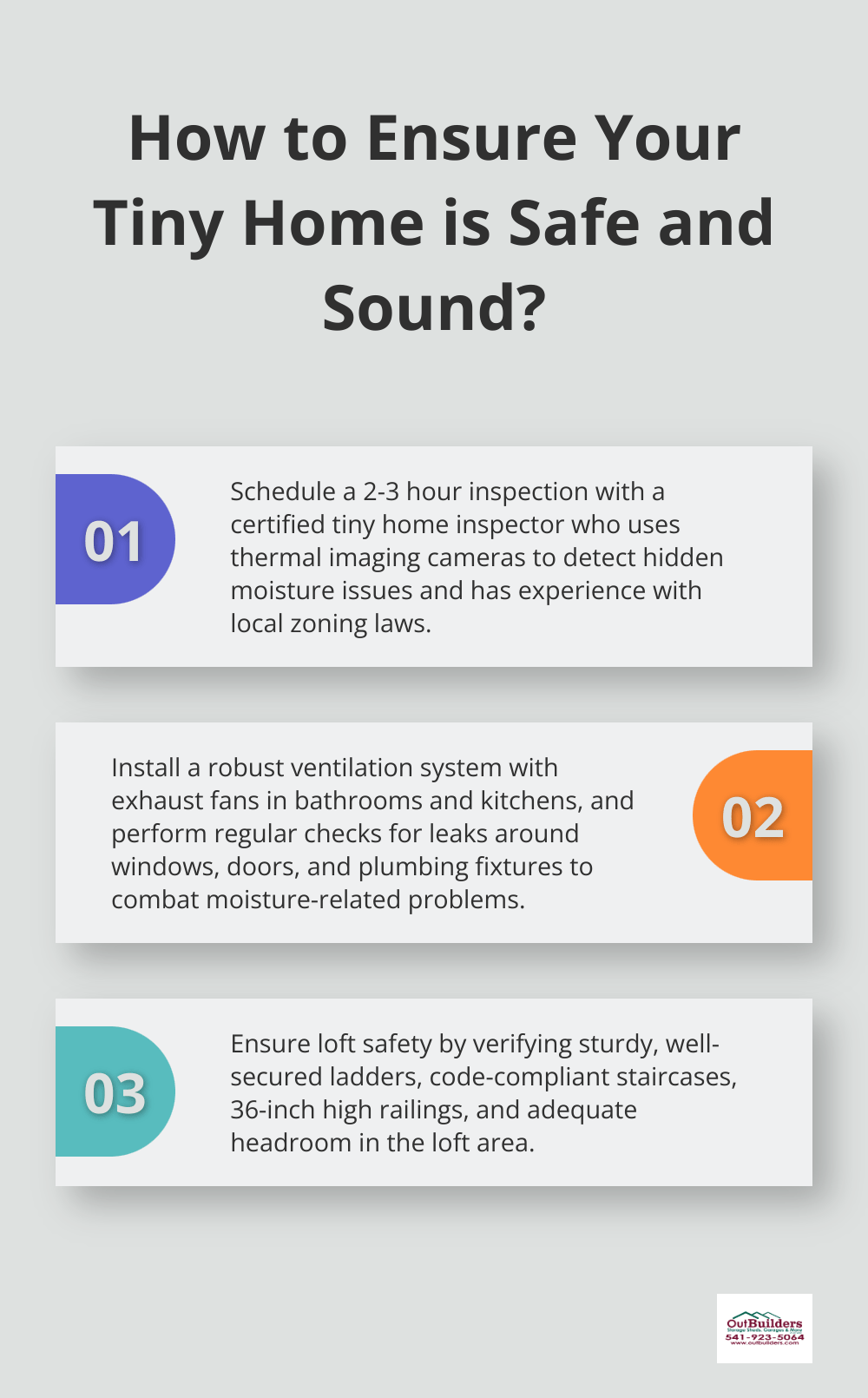
A qualified inspector who specializes in tiny homes can uncover hidden problems that might escape the untrained eye. Don’t hesitate to ask for references and examples of their previous tiny home inspections. Consider the long-term implications of your tiny home purchase, including future needs and potential for upgrades or modifications.
At Outbuilders, we understand the importance of quality construction and attention to detail. While we focus on creating custom storage solutions in Central Oregon, we recognize the value of professional inspections in ensuring the safety and longevity of any structure (including tiny homes). A tiny home inspection is an investment in your future comfort and peace of mind.

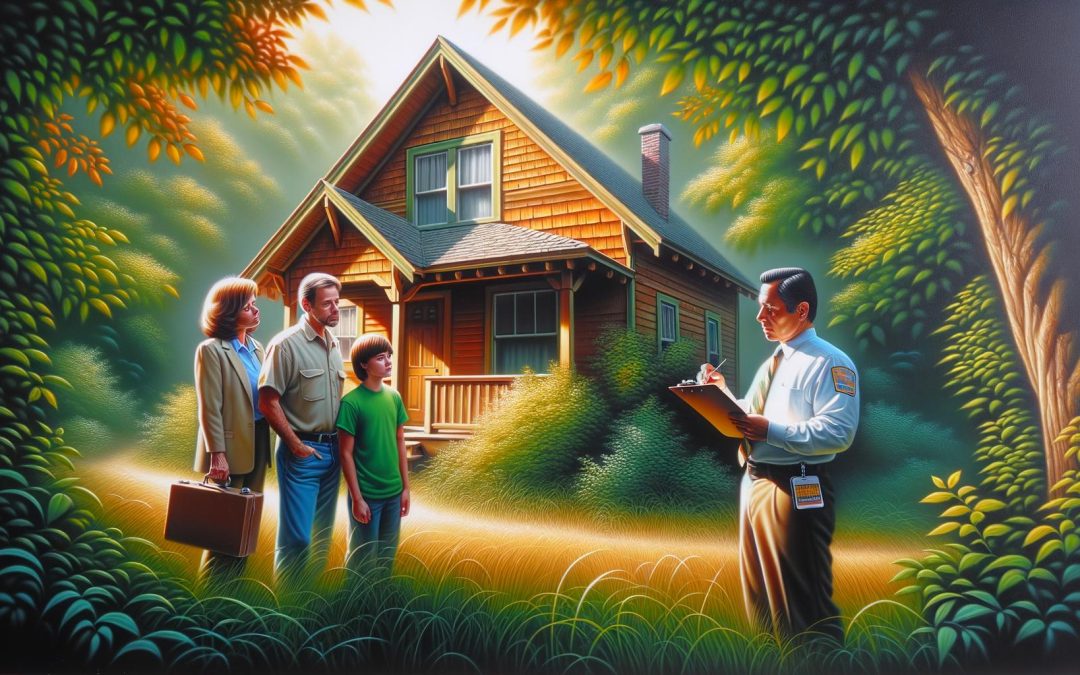





Recent Comments